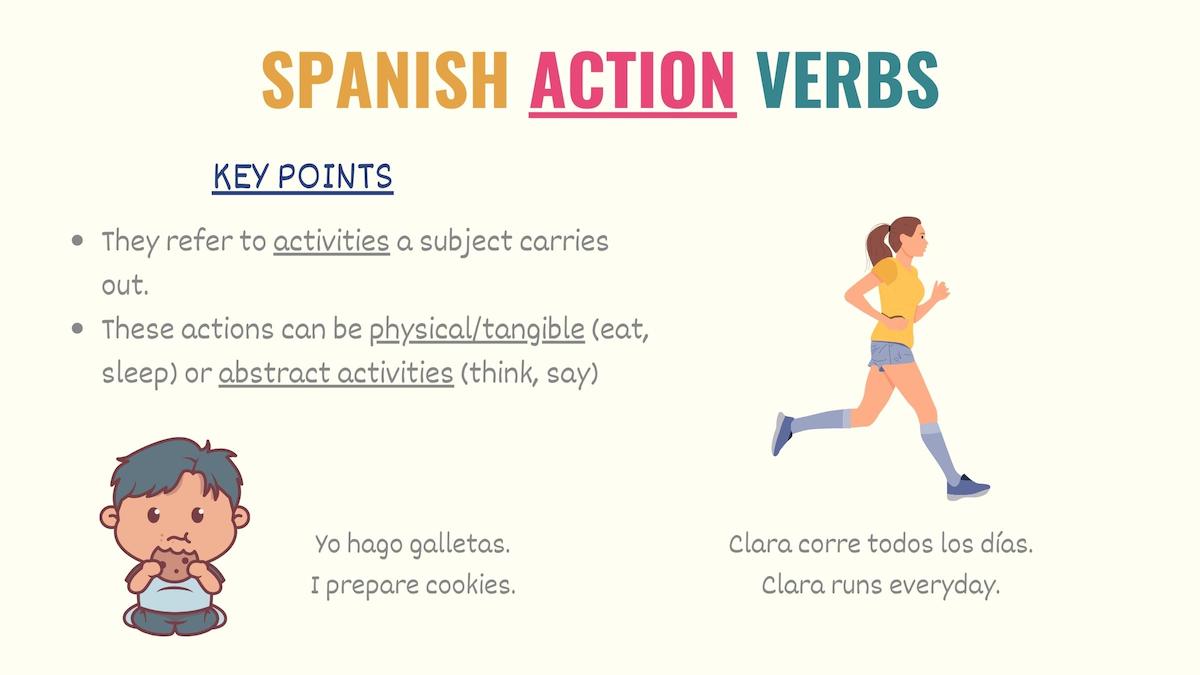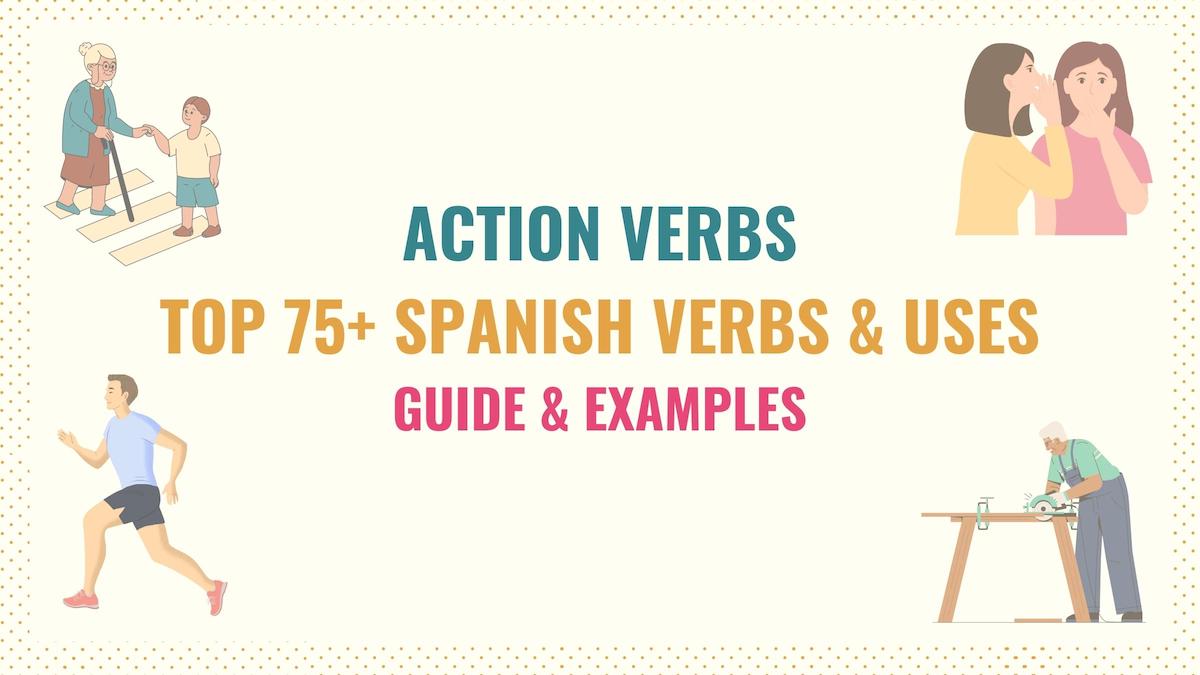Spanish action verbs are the type of verbs we use to talk about events, actions, and activities. In short, they’re pivotal for your conversations. With that in mind, in this guide, we’ll go over:
What Are Action Verbs & How to Use Them
In Spanish, action verbs express the actions the subject is doing or experiencing. In simple terms, these verbs refer to activities that people or things carry out.
Here are some sentences using verbs focused on expressing the action:
Elisa corre todos los días.
Elisa runs every day.
Las niñas juegan con la pelota.
The kids play with the ball.
Ayer limpié todas las ventanas.
Yesterday, I cleaned all the windows.
As you can see in the examples above, these verbs convey some sense of action or dynamism, unlike copulative and auxiliary verbs, such as haber, ser, parecer, etc:
| Other types of verbs | Action verbs |
|---|---|
| La niña es bonita. The girl is pretty | La niña baila flamenco. The girl dances Flamenco. |
In the first sentence (on the left), the verb describes the girl’s qualities. However, she’s not doing anything, whereas in the second sentence (on the right), she’s performing an action (dancing).
So, as you can see, Spanish action verbs are used to convey that a subject is doing something.

Take Note: An action verb in Spanish can be transitive if they need a direct object to complete its meaning (for example, comprar). However, action verbs can also be intransitive if the actions they describe stand alone (for instance, trabajar).
List of Most Common Spanish Action Verbs
Now that you know how these verbs work, here is a list with of the most common Spanish action verbs and some sentences showing you how to use them:
- Abrir: Open
- Agarrar: Grab
- Apagar: Turn off
- Aprender: Learn
- Arreglar: Fix
- Ayudar: Help
- Bailar: Dance
- Bañar: Shower / Bath
- Beber: Drink
- Buscar: Look for / Search
- Cambiar: Change
- Caminar: Walk
- Cantar: Sing
- Cepillar: Brush
- Cerrar: Close
- Cocinar: Cook
- Comenzar: Begin
- Comer: Eat
- Comprar: Buy
- Conducir / Manejar: Drive
- Conocer: Know / Meet
- Construir: Build
- Contar: Count / Tell
- Correr: Run
- Cortar: Cut
- Dar: Give
- Decir: Say
- Decidir: Decide
- Dejar: Leave
- Despedir: Fire
- Despertar: Wake up
- Dibujar: Draw
- Dormir: Sleep
- Encontrar: Find
- Entrar: Enter
- Escuchar: Listen
- Escribir: Write
- Estudiar: Study
- Explicar: Explain
- Guardar: Keep / Put away
- Hablar: Talk / Speak
- Hacer: Make/Do
- Ir: Go
- Jugar: Play
- Ladrar: Bark
- Lavar: Wash
- Leer: Read
- Levantar: Lift / Wake up
- Limpiar: Clean
- Llamar: Call
- Llevar: Carry
- Llorar: Cry
- Mirar: Look / Watch
- Morder: Bite
- Mostrar: Show
- Nadar: Swim
- Olvidar: Forget
- Pagar: Pay
- Pasar: Pass
- Pedir: Ask / Order
- Pensar: Think
- Perder: Lose
- Pintar: Paint
- Poner: Put
- Practicar: Practice
- Preguntar: Ask
- Preparar: Prepare
- Probar: Taste / Try
- Quebrar: Break
- Responder: Answer
- Reír: Laugh
- Romper: Break
- Saber: Know
- Sacar: Take out
- Saltar: Jump
- Salir: Leave
- Secar: Dry
- Sentir: Feel
- Seguir: Follow
- Terminar: Finish
- Tocar: Touch / Play
- Tomar: Take / Drink
- Traer: Bring
- Trabajar: Work
- Volar: Fly
- Vivir: Live
- Vender: Sell
- Ver: See
- Vestirse: Dress
- Viajar: Travel
- Visitar: Visit
Here are some sentences with action verbs:
Yo veo la tele.
I watch TV.
Esa bebé nunca llora.
That baby never cries.
James quebró dos vasos.
James broke two glasses.
El niño se viste solo.
The boy gets dressed on his own.
Ustedes hicieron muchas galletas.
You guys made a lot of cookies.
Sus hermanos fueron a la tienda.
Her brothers went to the store.
Nosotros trabajamos todos los días.
We work every day.
Take Note: Spanish reflexive verbs are action verbs since they refer to activities we do on ourselves.
Related Resources & Next Steps to Learn Spanish Verbs
In Spanish, there are different types of verbs, such as action verbs. Since they behave differently and work with specific elements, you should understand how each type works. Verbs are a crucial part of sentences, and they must be conjugated. Here’s a breakdown of the primary categories of different verbs in case you want to start learning them now:
- Action Verbs (covered above in this guide)
- Copulative Verbs
- Auxiliary Verbs
So, make sure you know how to conjugate verbs in Spanish. Remember that endings vary depending on the verb’s tense and ending (-AR, -ER, -IR). Finally, learn some Spanish adverbs because these words will help you describe how an action is done.
Download the Action Verbs in Spanish PDF
Learning Spanish involves studying grammar topics, vocabulary, and how to use the language as a whole in your conversations. This type of verbs is a critical part which you’ll use on a daily basis when speaking Spanish. To make your job a little bit easier, I’ve created a Free PDF you can download with the list of Spanish verbs and the highlights from this guide.



